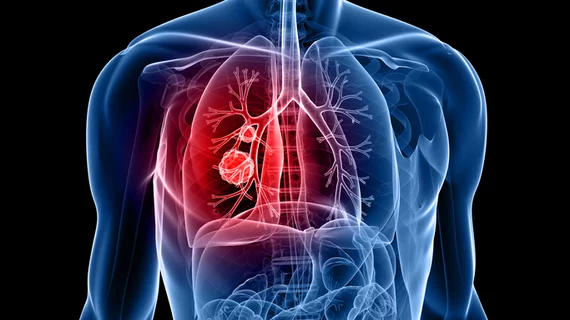Pre-treatment chest CT features can predict overall survival in lung cancer patients
Noncancerous chest CT image features identified prior to radiation therapy in patients with stage 1 lung cancer can be used to help predict overall survival.
A study published in the American Journal of Roentgenology used pretreatment chest CT scans obtained on 282 patients diagnosed with stage 1 lung cancer to evaluate how certain noncancerous measurements, such as coronary artery calcium (CAC) scores, pulmonary artery (PA)-to-aorta ratio, body composition and attenuation of skeletal muscle could be associated with overall post-treatment survival. Experts found that some of these features predicted overall survival better than clinical features alone.
“In patients undergoing SBRT for stage I lung cancer, higher coronary artery calcium (CAC) score, higher pulmonary artery (PA)-to-aorta ratio, and lower thoracic skeletal muscle index independently predicted worse overall survival,” corresponding author Florian J. Fintelmann, from the Division of Thoracic Imaging and Intervention at Massachusetts General Hospital in Boston, and co-authors explained.
Experts analyzed the chest CT scans of 282 patients (168 female, 114 male; median age, 75 years) with stage 1 lung cancer before they underwent stereotactic body radiation therapy (SBRT). The scans, which were retrospectively evaluated, were completed between January 2009 and June 2017. Overall survival was measured using clinical features only and in conjunction with noncancerous imaging features.
The patients had a median overall survival of 60.8 months. A total of 148 patients died, 83 of whom passed away from noncancerous deaths. The predictive model that used both clinical and noncancerous imaging features was found to be the most accurate, with an AUC of .75 compared to .61 for the model that used clinical features alone. Researchers observed that higher CAC score, higher PA-to-aorta ratio and lower thoracic skeletal muscle index were all independently linked with worse overall survival, though PA-to-aorta ratio was found to be most significantly associated with poor outcomes.
“The PA-to-aorta ratio, which is readily quantifiable with electronic calipers during routine image review, was the most important predictor of overall survival,” the authors wrote.
The noncancerous imaging features obtained before SBRT were indicative of overall survival in stage 1 lung cancer patients and could be used in the future to help guide treatment decisions for these patients, the experts noted.
Related computed tomography content:
Risks of stroke and heart attack increase with larger thoracic aortic diameter, research shows
Patient-reported risk factors increase unnecessary testing before contrast-enhanced CT
Patients' T-shirt size an accurate measurement for CT dose reference levels
Lung cancer screenings are proven to save lives, but disparities remain, experts discover

